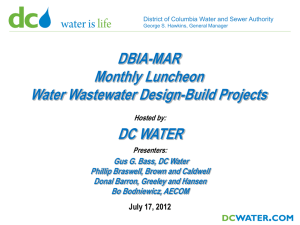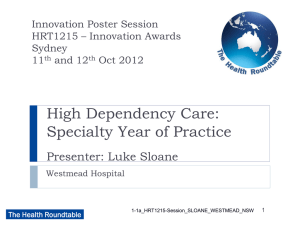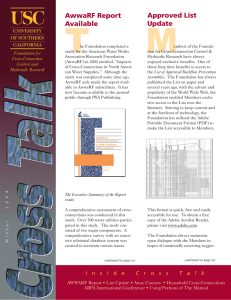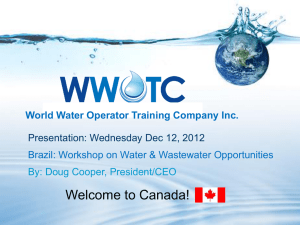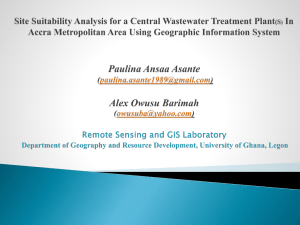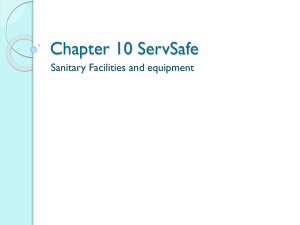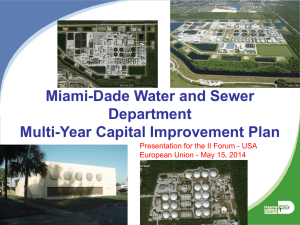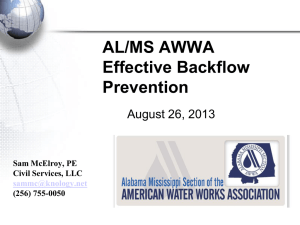All Hazard Water Resiliency Training (AHWRT)
advertisement
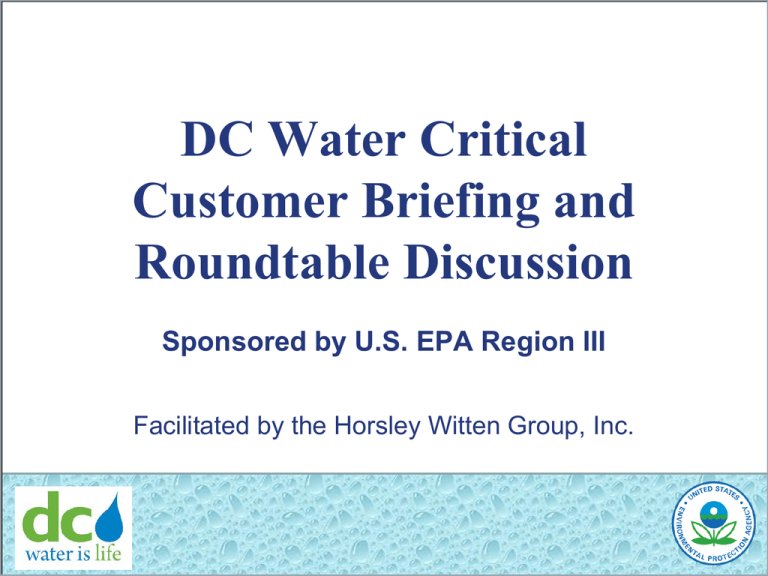
DC Water Critical Customer Briefing and Roundtable Discussion Sponsored by U.S. EPA Region III Facilitated by the Horsley Witten Group, Inc. Agenda 9:00 – 9:30 Check-in & Networking 9:30 – 9:45 Welcome & Introductions 9:45 – 10:30 Presentations 10:30 -10:45 Break & Networking 10:45 – 11:30 Presentations 11:30 – 12:30 Lunch & Networking 12:30 -1:30 Roundtable Discussion 1:30 - 1:45 Break/Networking 1:45 - 3:00 Roundtable Discussion 3:00 - 3:30 Next Steps/Closing Remarks Administration/Logistics Check-in Breaks Cell phones Restrooms Emergency procedures Roundtable material Questions/concerns Introductions Presentations Drinking Water Source & Treatment Process – Thomas Jacobus, Washington Aqueduct Water Distribution & Sewer Collection Systems – Jason Hughes, DC Water Sewer Treatment – Aklile Tesfaye, DC Water Water Quality & Cross Connection Control – Pierre Constant & Jessica Edwards-Brandt, DC Water Water Operations & Repair – David Wall & Marlee Franzen Emergency Preparedness & Response – Jonathan Reeves & Geneva Green Washington Aqueduct Presentation to DC Water Critical Customers February 6, 2015 Safe – Reliable – Cost Effective Owned and Operated by the US Army Corps of Engineers, Baltimore District 5 Water Supply & Major Facilities You are here 6 Water Treatment Process (Conventional Treatment) 7 Dalecarlia Water Treatment Plant Treats between 100-160 million gallons per day 8 Georgetown Sedimentation Basins 9 McMillan Water Treatment Plant Treats between 60 - 120 Million gallons per day 10 What could cause a disruption or limitation in service? Improper treatment Operator Error Component malfunction Electrical power interruption Hostile external act against system infrastructure Contaminated source water (i.e., Potomac River) Extended severe drought 11 Washington Aqueduct Baltimore District US Army Corps of Engineers 12 Water Distribution and Sewer Collection Systems Critical Customers Jason Hughes Director of Utilities Services - Water Water Distribution System Water Distribution System • • • • Total Coliform Rule Lead and Copper Rule Disinfection By-Product Rule Unregulated Contaminant Monitoring Rule (UCMR3) Sewer Collection System • • • • Total Coliform Rule Lead and Copper Rule Disinfection By-Product Rule Unregulated Contaminant Monitoring Rule (UCMR3) DC Water Clean Rivers “A Drop’s Life” https://www.youtube.com/watch?v=5Ug1hravb9Q Sewer Treatment Critical Customers Aklile Tesfaye Director of Wastewater Treatment Providing Essential Services Potomac River Water treatment Blue Plains Regional Wastewater Treatment Plant Wastewater Collection System Distribution System Sanitary Sewage Stormwater Runoff Blue Plains Advance Wastewater Treatment Plant Blue Plains Advanced Wastewater Treatment Plant February 6, 2015 Capacity: 370 MGD Average Annual Flow 891 MGD Peak Flow 19 Blue Plains Service Area DC Water’s Advanced Wastewater Treatment Plant at Blue Plains is the largest of its kind in the World Blue Plains AWT provides wastewater treatment services to 2.1 million people in the District of Columbia and the surrounding counties in Maryland and Virginia Services both combined & separate sewer system Wastewater Treatment • Regulated by EPA with STRINGENT permit requirements • Excellent history of treatment performance • Uses physical, chemical, and biological treatment processes, including innovative green technology • O&M staff ~ 270 • Direct O&M cost~ $1,100/MGD 21 DC Water Pretreatment Program Purpose: • To prevent the introduction of pollutants into the collection system or at the wastewater treatment that may: (a) Impact public & employee health and safety, wastewater treatment O&M (b) Cause pass-through pollutants and result in adverse environmental impact, and (c.) Violate water quality and biosolids standards and NPDES permit requirements Permits: • Significant Industrial User, Non-Significant Industrial User, Temporary Discharge Authorization, Waste Hauler Permit Report A Problem: To report spills and unusual discharge observations, call (202) 612-3400 – 24 hours Information of the Pretreatment Program: Call the Pretreatment Program Manager at 202-787-4177 with general questions or email to Elaine.wilson@dcwater.com BREAK 23 Drinking Water Quality Monitoring Critical Customers Jessica Edwards-Brandt Manager of Water Quality Water Quality Monitoring Regulated Programs • • • • Total Coliform Rule Lead and Copper Rule Disinfection By-Product Rule Unregulated Contaminant Monitoring Rule (UCMR3) Water Quality Monitoring Non-Regulated Programs • • • • • • • • Customer Complaint Investigations Routine Monitoring at Schools and Daycares Water Security Monitoring – Online Monitoring Water Quality Problem Area Investigations Lead Pipe Loop Research Lead Sampling and Profiles Nitrification Tests Following Main Breaks Cross-Connection Control Before and During the Next Event Critical Customers Pierre Constant Supervisor of Cross Connection & LSLR Programs Outline • Key terms • Some facts about the Cross-Connection Control program • How to prepare for a water contamination event (ccc perspective) • What do you do if there is an internal water contamination event • What do you do if DC Water issues an advisory in your area Key terms • Cross-connection-Any actual or potential connection between the drinking water system and a source of contamination or pollution. • Backflow- The reverse flow of water or other liquids, mixtures, or substances into the drinking water system. • Backflow Preventers-mechanical devices or assemblies which prevent the reverse flow of water or other liquids, mixtures, or substances into the drinking water system Facts of the Cross-Connection Control Program • Some Facts – Primary responsibility for the administrating and enforcing all cross-connection control regulations in DC – Responds to about 6 water quality investigations per year – Completes about 400 inspections per year – Collects and processes about 4000 inspection reports per year – Tracks about 7000 backflow preventers at 2,600 different sites • DC Water Cross Connection Control Program 202-364-3143 crossconnections@dcwater.com http://www.dcwater.com/cc/default.cfm How to prepare for a water contamination event (part 1) 1. Identify your cross-connections and assess the potential hazards Look for water connections to boilers, chillers, pools, softeners…….. 2. Compile and review safety data sheets to assess hazards Look at all chemicals both those used for water treatment and used for everyday functions How to prepare for a water contamination event (part 2) 3. Determine if the appropriate backflow preventer is installed Refer to DC Plumbing Code and licensed plumbers 4. Inspect, test and tag your backflow prevention assemblies DC Regulations require annual testing and report submittal to DC water 5. Determine how to isolate water service to each cross-connection Reduced Pressure Backflow Prevention assembly What do you do if there is an internal water contamination event – Isolate the contaminate and/or system – Instruct your occupants to “do not use” the water – Contact DC Water 202-612-3400 How does DC Water investigate an internal water contamination event – Take water samples – Inspect cross-connections, backflow preventers and water source systems – Review safety data sheets – Ask questions What do you do if DC Water issues an advisory in your area • • • Communicate the advisory to your occupants Assess the need to isolate water to sensitive equipment and systems – e.g. dialysis water treatment units, sinks in surgical areas…….. Assess your water needs and make alternative plans Review • How to prepare for a water contamination event 1. 2. 3. 4. 5. Identify your cross-connections and assess the potential hazards Compile and review safety data sheets to assess hazards Determine if the appropriate backflow preventer is installed Inspect, test and tag your backflow prevention assemblies Determine how to isolate water service to each cross-connection • What do you do if there is an internal water contamination event • • • Isolate the contaminate Issue a “do not use” to occupants Call DC Water 202-612-3400 • What do you do if DC Water issues an advisory in your area • • • Communicate the advisory to your occupants Assess the need to isolate water to sensitive equipment and systems Assess your water needs and make alternative plans Questions? • DC Water 24-hour Emergency Hotline 202-612-3400 • DC Water Drinking Water Branch 202-612-3440 drinkingwater@dcwater.com http://www.dcwater.com/drinking_water/default.cfm • DC Water Cross Connection Control Program 202-364-3143 crossconnections@dcwater.com http://www.dcwater.com/cc/default.cfm Water Distribution Operation and Maintenance Critical Customers David Wall – Manager of Water Distribution Control Marlee Franzen – Manager of Water Distribution Maintenance Operations and Maintenance • General System Operations • Maintaining the System • Water Main Emergencies • Capital Improvement Projects 2 General System Operations What are our responsibilities? - Oversee the coordination of all valve and hydrant operations for all activities on the water distribution system. What is our Objective? - Deliver an uninterrupted water supply with adequate pressure and flow for fire protection and consumption. 40 General System Operations What we will be doing in the next 12 months? - Flushing over 540 miles of mains - Performing over 20,000 valve operations. - 1,000 Fire Hydrant Flow Tests - Over 10,000 Fire Hydrant maintenance activities - Responding to over 4,000 problems reported on the water system. 41 General System Operations What you might experience as a result of all these activities? - Temporary reduction of pressure/flow. - Discolored Water - Temporary loss of service. (Typically, 6-12 hours) 42 Old Infrastructure = Emergencies Repair 300-400 Water Main Breaks a Year. Valves, seals, pumps and other parts also need to be replaced. 43 Prioritization 44 Repairs and Improvements • Minimize debris from entering the main • Disinfect the pipe following the repair • Data collection to help target replacement segments • Redundancy 45 Capital Improvement Program • DC Water’s Goal: Renew 1% per year • Many water main candidates vying for selection − 700 miles - unlined cast iron − 300 miles - older than 100 years − 50 miles - identified Water Quality concern areas • Identify water mains most in need of replacement • Utilize a customized AWWARF Deterioration Point Assignment • Weighting & criteria based on DC Water high priority initiatives and availability/accuracy of data 46 Customer Services Critical Customers Geneva Green Call Center Supervisor Contact DC Water Call: (202) 612-3400 – 24 hours We want to know: What is occurring? Where is the issue located? Is the issue causing damage or injury? What investigation has already been done by your property manager? Who do you want to be our point of contact in repair/investigation and contact information (phone, email) An Investigation crew will be dispatched to the location for an assessment. Additional investigation or repair work follows the assessment if required. Click: http://www.dcwater.com/report_problem/default.cfm Report A Problem: Report an issue or request assistance by completing the Report A Problem form on our website if you prefer not to call. PLEASE – do not use this if the issue requires immediate attention Information & Updates Scheduled & Emergency Work: Customers are notified at least 24 hours in advance of scheduled or planned work. Emergency work is the result of an unplanned issue requiring an immediate repair. Updates Scheduled and Emergency work is posted on the website under the ‘In Your Neighborhood’ section. Customers can sign up for mobile text alerts when work is posted in a selected zip code, and call the Command Center to receive the most current information from crews on location. Report a problem – for routine maintenance requests 50 Workzone Alerts http://www.dcwater.com/workzones/default.cfm 51 Emergency Preparedness & Response Critical Customers Jonathan Reeves Office of Emergency Management Manager Questions & Comments ??? 53 Critical Customer Roundtable Discussion Roundtable Discussion Who: Critical Customers What: Participate in a facilitated informal discussion Why: To determine where water emergency planning improvement is needed How: Through honest, candid discussion of a fictitious scenario Roundtable Discussion Objectives • Discuss expectations, roles, capabilities and limitations of partner agencies in the event of a major water emergency. • Determine where water emergency planning improvement is needed. • Provide an opportunity for critical customers to engage with service providers to create an effective and efficient foundation for community resiliency. • Discuss assistance available to increase preparedness for and resilience to a reduction/loss of service. Roundtable Structure • Facilitator-led discussion • Minimal simulation, no attempts to arrange elaborate facilities or communications • Informal and stress-free • Success hinges on your participation and feedback • Next step discussion Roundtable Rules • Dialogue is encouraged within a safe, open, stress-free environment • Respond based on your knowledge • One person talks at a time • Don’t “fight” the scenario Tuesday 8:45 AM DC Water’s operational command center receives an increase in calls from customers complaining of low and no water pressure in the northwest quadrant of the city. Tuesday 12:45 PM DC Water’s on-scene commander determines that water must be completely shut off in order to determine the extent of the problem. Tuesday 5:00 PM A DC Water spokesperson reports that crews are working non-stop to identify the extent of the problem that has caused the water outage in NW D.C. DC Water officials do not have a definitive answer on when service will be restored. An onsite worker was quoted as saying “this could last a couple more hours or a couple more days”. Wednesday 8:45 AM It has been determined that a one-of-a-kind component of the distribution system, originally installed in 1923, has failed. DC Water is in contact with vendors and NCR WARN to locate a suitable replacement. If a replacement cannot be located, then the component will have to be manufactured, which could take a week or more. Thursday 12:00 PM A suitable replacement has been located at LADWP and is being flown to DC. The component should be onsite late this evening. Once installed, DC Water will begin reestablishing service to the affected area. Roundtable Discussion Objectives • Discuss expectations, roles, capabilities and limitations of partner agencies in the event of a major water emergency. • Determine where water emergency planning improvement is needed. • Provide an opportunity for critical customers to engage with service providers to create an effective and efficient foundation for community resiliency. • Discuss assistance available to increase preparedness for and resilience to a reduction/loss of service. Next Steps Discussion Items: Please fill out your Participant Feedback Form Thank You!


